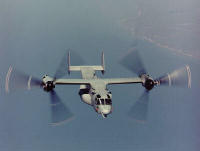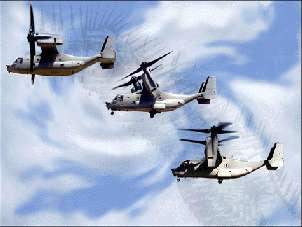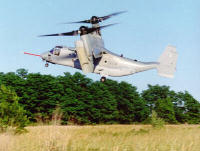V-22 Osprey
From the Owl to the Osprey

Throughout history, humans have been amazed with flight. The birds could soar through the air with such ease and gracefulness. Man's dream of flight became a necessity and the necessity became the mother of invention.
Thousands of years ago the Chinese used kites that were used for transportation, informing, and celebration. These kites were sometimes used to send information from one village to another. The rigid design of the kites helped the device to fly.
Later, on the other side of the world, some people had jumped off towers and cathedrals to try and fly. Some of these people perished after rough landings. In 852 AD, Armen Firman jumped off a tower in Cordoba, Spain wearing a voluminous cloak that he thought would help him glide to the ground like a bird. However, instead of him gliding down to the ground, air got caught in the cloak causing it to act like a parachute.
Most people who dreamed of flying thought that the flying device had to look and flap like a bird. Others attached feathers to themselves while they jumped, thinking it would help them to fly. Some of the most genius of inventors came to dead ends with the idea of copying the bird. The kinds of flying machines that flapped like birds came to be known as ornithopers.
In 1783, the Montgolfier brothers used their hot air balloon to send a duck, rooster, & sheep up before King Louis XVI and Marie Antoinette and on November 21, 1783, they sent Jean Francois Pilatrede Rozier and Marquis d'Arlandes into the air to become the first humans to fly in a balloon. This flight over Paris was five miles long and lasted twenty-five minutes. A hydrogen filled balloon, made by Jacques Charles, flew over Paris for two hours on December 1, 1783.
After the failures of the ornithopers, many of the flight inventors decided to try to make something that could fly that had rigid wings. This kind of flying device that was often kept aloft by the wind became known as a glider. The gliders, like the ornithopers, were often made into models but were never produced. Sir George Cayley's "Boy Glider" built in 1849 is credited as the first inherently stable full-sized heavier-than-air craft.
The gliders design and abilities could only rely on the wind. On December 17, 1903 Oliver and Wilbur Wright achieved the first sustained and controlled flight from level ground. The amazing part of this feat was not just that they flew but that they flew by their own power source of an engine instead of the wind. They had control of the craft and did not have to rely on where the wind blew them. Oliver and Wilbur Wright's aircraft became known as an airplane, which is a heavier-then-air, engine powered, and rigid winged craft that has control surfaces that move on the wings and tail to control the aircraft.
In 1490 Leonardo da Vinci designed a kind of flying device that did not have rigid wings and worked like the windmill. Rotor power became a real possibility when a Frenchmen by the name of Louis Charles Breguet made a flying machine that could hover, and that was first flown on September 29, 1907. The first man to be lifted by a vertical lift craft was Paul Cornu from France on November 13, 1907. The autogiro, a machine with a rotor that was not attached to the engine but turned by the air rushing past it and was pulled along by a different propeller, was invented by Juan de la Cierva and first flown in January of 1923. Heinrich Focke made the first practical helicopter that was successfully flown on June 26, 1936. The early helicopter ran into the problem of not flying straight until Igor Sikorsky invented the rear rotor, first used on a helicopter on December 8, 1941, that counteracted with the torque of the main rotor. This invention helped to keep the helicopter flying straight instead of spinning like the main rotor.
In the 1930's a new kind of flying machine was proposed. The Baynes Heliplane from Britain proposed the idea of the tiltrotor concept. This concept allowed for the aircraft to fly horizontally and vertically. After World War II experimenters tried to make the concept work. Robert Lichten, one of the first to work with the idea, made his first tiltrotor craft in 1954. It did manage to hover several times but the full conversion from vertical to horizontal or vice versa was never accomplished. Five years later both Lichten and the Bell Helicopter Company achieved this with their XV-3 tiltrotor aircraft. In 1971 a joint project between NASA and the army was given a fifty million dollar budget to build a tiltrotor to test for problems that would need to be solved if tiltrotors were ever going to fly. The first flight of the XV-15 occurred on May 3, 1977 and proved that the tiltrotor concept did work. The 1980's brought a push for tiltrotors by government officials. The V-22 Osprey was the tiltrotor transport that the military wanted that took the concept of the tiltrotors and improved it to make it practical. The first flight of the Osprey occurred on March 19, 1989, opening a whole new era of flight.
On April 24, 1980 an operation on the Iranian desert was unraveling. The mission was to take the eight helicopters from the USS Nimitz, fly to the helicopters first station to refuel, board troops, move to a hiding place at their second station, wait for night, truck the troops to the embassy where the hostages were, rescue the hostages, meet and reload the helicopters, fly to meet some large transport airplanes and fly to safety. The estimated time for the mission was three days. This never happened, three of the helicopters failed before even arriving to the first station for refueling. The mission was called off by the colonel in charge even before the explosion of a fuel tank at the station when a helicopter and airplane collided. The public was outraged that the mission failed, but some took the failure and considered what could have been done differently. The necessity of finding a solution became the mother of invention. The thirty-year-old idea of a tiltrotor aircraft was still in the idea stage and had not been approached as a possibility. The government liked the idea and gave the project to the Bell Helicopter Textron and Boeing Company who built the V-22 Osprey.
The V-22 Osprey could have done the Iranian hostage mission in only eight hours and without killing eight men and loosing equipment and supplies. One reason that the Osprey could take less time is because the fastest of helicopters can only go about 200 miles per hour whereas the Osprey can go 394 mph. An airplane may seem to be a better idea, however the Osprey does not need a runway to takeoff or land like an airplane because it can land vertically like a helicopter. Some of the stations on the mission were for refueling of the helicopters. The Osprey can refuel in midair as some of the airplanes do in order to fly for longer periods of time.
Some detractors have questioned the safety of a tilt rotor aircraft. When an engine fails on an airplane, it usually keeps going on its remaining engines or it glides down for an emergency landing. A helicopter uses a concept called autorotation where the rotor keeps turning even though it is not powered by the engine. This allows for it to use the momentum, gravity, and the air to make an emergency landing. When one engine goes out on the Osprey the interconnect driveshaft connects the engines with the transmissions for the propellers so that both the propellers are powered by the one engine until the pilot can make a safe landing. Autorotation is the only option for emergency landings when the Osprey is making vertical landings and takeoffs. Currently engineers are working on making a way that the Osprey can use autorotation for emergency landings if it is in the vertical position.
The Osprey is designed to be used on ships as well as airports. On missions, the time allotted to move an aircraft out of the way of the next one coming in is minimal. Airplanes take an entire runway to stop and be steered around whereas the helicopter and the Osprey can land in a minimal amount of space. The helicopter takes up a certain amount of room when landed, however, the Osprey can fold up to take up a minimal space on deck when it is not being used. The wings become parallel to the top of the Osprey and the blades of the rotors are folded toward the middle of the aircraft. This conversion to being folded or to be unfolded takes a remarkable ninety seconds so that a large number of them can come in or go out in a very little amount of time.

The future of the V-22 Osprey depends on what it is being used for and the problems that are found with it. Autorotation and the problems addressed with the emergency landings of the Osprey will be solved. The idea of making the rotors bigger for more thrust and power is being considered along with the idea of making the entire Heliplane bigger so that it can carry more military vehicles and personnel. Currently the Osprey can carry 24 fully armed Marines and their crew chief, however a future in the commercial airline industry is being considered for the design. Transportation from landing areas to major airports and routes from one airport to another are some of the considerations for Heliplanes.
We have come a long way from dreaming about flight to flying like a hummingbird in an Osprey. First we were tethered to the ground on kites and balloons. These gave us insight to the basics of air currents and flight. The glider and airplane gave us controlled flight and the helicopter gave us vertical flight capabilities. Heliplanes, such as the Osprey, has given us not only the best of both worlds but assured us that the old adage is true, necessity is the mother of invention!

The following resources were used.
Books:
1) Berliner, Don. Before The Wright Brothers. Minneapolis: Lerner Publications Company, 1990.
2) Stacey, Thomas. Airplanes: The Lure of Flight. San Diego: Lucent Books, 1990.
3) Moolman, Valerie. The Road To Kitty Hawk. Alexandria: Time-Life Books, 1980.
Encyclopedias:
4) McCormick, Barnes W. "Helicopter." Microsoft Encarta Encyclopedia 2000. 2000 edition. CD-ROM.
5) Tripp, Thomas M. "Airplane" Microsoft Encarta Encyclopedia 2000. 2000 edition. CD-ROM.
Magazines:
6) Larson, George C. "Extreme Machine." Air & Space Nov. 1998: pp 26-35
World Wide Web:
7) "Balloon." 10 May, 2001. http://www.britannica.com/eb/article?eu=1580&tocid=0
8) "Aviation." 10 May, 2001. http://www.britannica.com/eb/article?eu=1580&tocid=0
9) "V-22 Nose To Tail." 27 May, 2001. http://www.airspacemag.com/asm/mag/supp/on98/osprey.html
10) Mark, Hans. "Straight Up Into The Blue." 27 May, 2001. http://www.sciam.com/1097issue/1097mark.html
11) "V-22 Osprey." 25 May, 2001. http://www.navair.navy.mil/v22/
12) "Bell Boeing V-22 Osprey." 28 May, 2001. http://www.bellhelicopter.textron.com
Information Hangar Specifications Gallery

View My Guestbook
Sign My Guestbook
This web page is for hobby purposes only and is not affiliated with any company, corporation, or organization. The webmaster can be contacted at brasstring@yahoo.com concerning this website.




